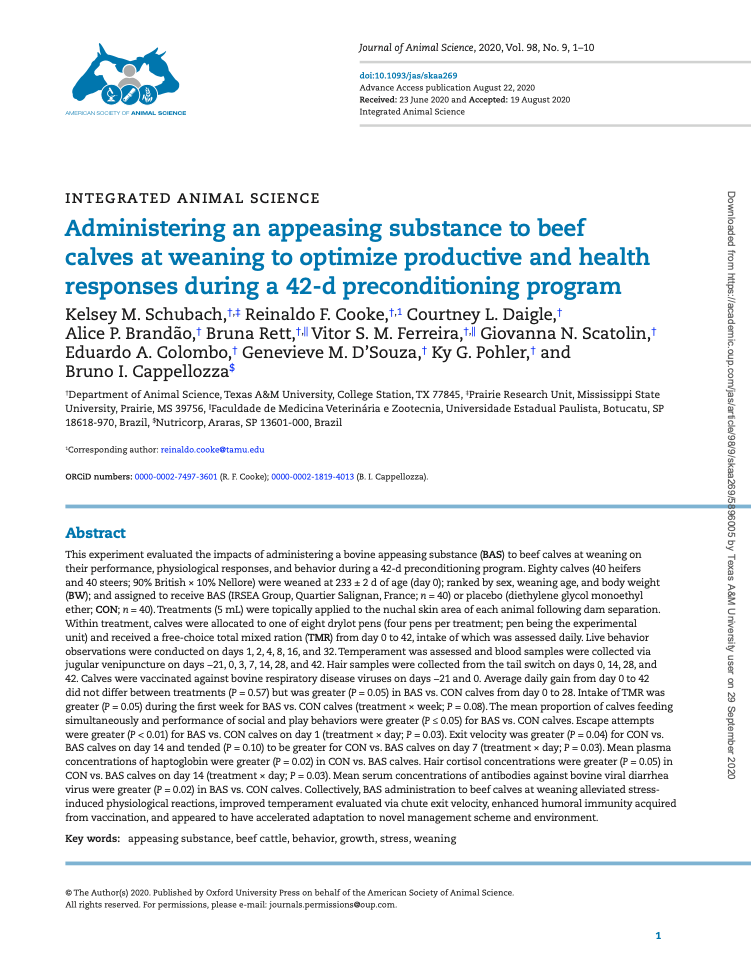Abstract:
This experiment evaluated the impacts of administering a bovine appeasing substance (BAS) to beef calves at weaning on
their performance, physiological responses, and behavior during a 42-d preconditioning program. Eighty calves (40 heifers
and 40 steers; 90% British × 10% Nellore) were weaned at 233 ± 2 d of age (day 0); ranked by sex, weaning age, and body weight (BW); and assigned to receive BAS (IRSEA Group, Quartier Salignan, France; n = 40) or placebo (diethylene glycol monoethyl
ether; CON; n = 40). Treatments (5 mL) were topically applied to the nuchal skin area of each animal following dam separation. Within treatment, calves were allocated to one of eight drylot pens (four pens per treatment; pen being the experimental
unit) and received a free-choice total mixed ration (TMR) from day 0 to 42, intake of which was assessed daily. Live behavior observations were conducted on days 1, 2, 4, 8, 16, and 32. Temperament was assessed and blood samples were collected via jugular venipuncture on days −21, 0, 3, 7, 14, 28, and 42. Hair samples were collected from the tail switch on days 0, 14, 28, and
42. Calves were vaccinated against bovine respiratory disease viruses on days −21 and 0. Average daily gain from day 0 to 42
did not differ between treatments (P = 0.57) but was greater (P = 0.05) in BAS vs. CON calves from day 0 to 28. Intake of TMR was greater (P = 0.05) during the first week for BAS vs. CON calves (treatment × week; P = 0.08). The mean proportion of calves feeding simultaneously and performance of social and play behaviors were greater (P ≤ 0.05) for BAS vs. CON calves. Escape attempts were greater (P < 0.01) for BAS vs. CON calves on day 1 (treatment × day; P = 0.03). Exit velocity was greater (P = 0.04) for CON vs. BAS calves on day 14 and tended (P = 0.10) to be greater for CON vs. BAS calves on day 7 (treatment × day; P = 0.03). Mean plasma concentrations of haptoglobin were greater (P = 0.02) in CON vs. BAS calves. Hair cortisol concentrations were greater (P = 0.05) in CON vs. BAS calves on day 14 (treatment × day; P = 0.03). Mean serum concentrations of antibodies against bovine viral diarrhea virus were greater (P = 0.02) in BAS vs. CON calves. Collectively, BAS administration to beef calves at weaning alleviated stress- induced physiological reactions, improved temperament evaluated via chute exit velocity, enhanced humoral immunity acquired from vaccination, and appeared to have accelerated adaptation to novel management scheme and environment.
Auteur: Kelsey M. Schubach, Reinaldo F. Cooke, Courtney L. Daigle, Alice P. Brandão, Bruna Rett, Vitor S. M. Ferreira, Giovanna N. Scatolin, Eduardo A. Colombo, Genevieve M. D’Souza, Ky G. Pohler, and Bruno I. Cappellozza
En savoir plus: https://academic.oup.com/jas/article-abstract/98/9/skaa269/5896005?redirectedFrom=fulltext

